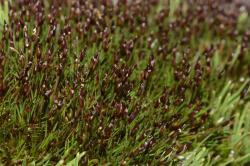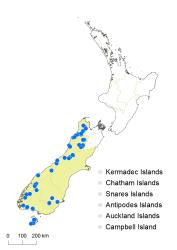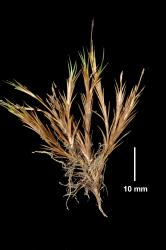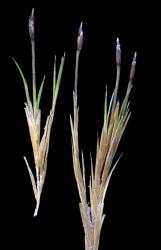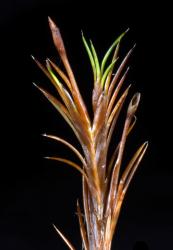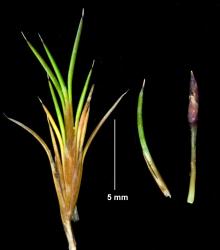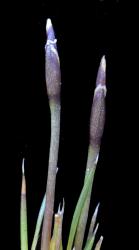- Taxon
- Gallery
Perennial cushion, 15–80 mm high. Stems ascending, much branched towards the base. Leaves densely distichous, imbricate, weakly spreading to erect. Leaf-sheath, 3.2–6 mm long, scarious, glabrous, shiny red-brown, auricles absent, long ligulate with an acute apex. Leaf-lamina 4–8 × 0.3–0.5 mm, setaceous with a long hyaline acicular tip, terete to faintly channelled, glabrous. Uppermost leaf normal. Flowering stems 8–20 mm long, glabrous. Inflorescence a narrow ovoid spike, 2.8–5.0 × 0.7–1.0 mm, with 2–3 alternate bracts. Inflorescence bracts separated by a flattened internode, 1.5–2.0 mm long. The lowermost bract, 2.0–3.0 mm long, ovate with an acuminate or mucronate apex, occasionally emarginate, always subtending a bisexual flower, the smaller second bract subtending a bisexual flower or sterile, the third bract if present sterile. Androecium, stamens 2, free; filament capillary, 1.5–2.8 mm long; anthers 0.5–0.8 mm long, ellipsoid. Gynoecium a collateral bilocular ovary; styles 2, free; apical stigmatic part of style crowded with branched papillae, white. Seeds 0.8–1 × 0.28–0.4 mm, oblong-ovoid, yellow-brown or red-brown, faintly striated.
Distinguished from the two bog species of Centrolepis (C. ciliata and C. pallida), by 2–3 distinctly alternate inflorescence bracts, shiny red-brown or brown leaf-sheaths and the laminae with long hyaline needle-tips. Often found in close proximity with C. ciliata, but easily distinguished from that species, which has hairy leaf-sheaths, whereas Gaimardia setacea is completely glabrous.
South Island: Nelson, Canterbury, Otago, Westland, Southland, Fiordland, Stewart Island.
Also recorded from Tasmania and New Guinea.
Subalpine to alpine bogs, peat and sphagnum bogs, turfs, wet open heathland from 400 to 1500 m.
Flowering: Nov.–Jan.



